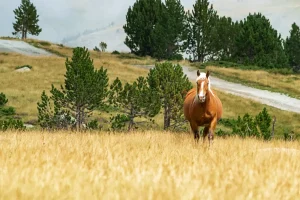Many people share the dream of embarking on the journey of owning and managing a ranch. Whether you envision a serene getaway in the countryside or aspire to delve into the world of agricultural enterprises, understanding the crucial factor of land requirement is paramount. However, determining the appropriate amount of land needed for a ranch involves many considerations, from the type of activities you plan to engage in to the size and type of livestock you intend to raise.
In this article, you’ll discover how much land do you need for a ranch, the intricacies of land allocation, and explore the factors influencing the necessary land area. We will explore various ranches, from small-scale hobby farms to large-scale commercial operations, and examine the land requirements for livestock, forage production, infrastructure, and environmental considerations. Let’s dive in!
What Is a Ranch?
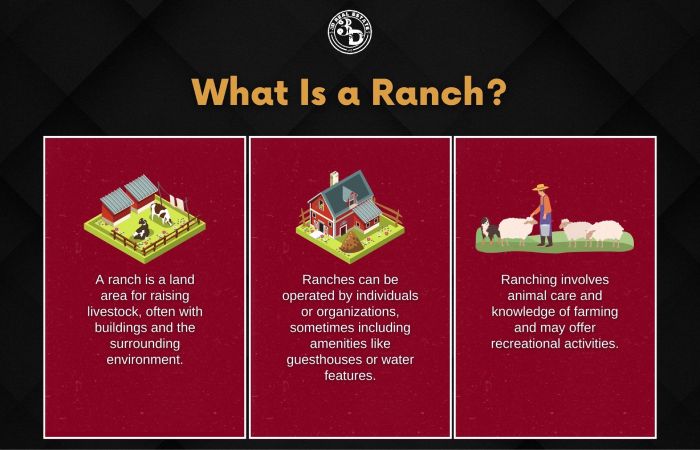
A ranch is an area of land used to raise livestock. It can refer to both the farm and the buildings on it and its surrounding environment. The term originates from the Spanish word ‘rancho,’ used for small farms in the 18th century. A single-family or organization typically operates ranches, although some may be leased to others. They may include additional amenities such as guesthouses, barns, and stables or water features such as ponds or streams.
Ranching involves working with animals in their natural habitat. It requires knowledge of animal husbandry, veterinary care, and the right way to start a farm. In addition to raising cattle, sheep, goats, and horses, ranches may also provide recreational activities such as hunting, fishing, and hiking trails.
When considering a potential ranch property, several factors must be considered. These include parcel size, zoning regulations, access roads/bridges, and availability of water sources.
Factors to Consider When Choosing a Ranch Land
When determining how much land you need for a ranch, it’s essential to consider the specific requirements of your intended operation. Here are some factors to consider:
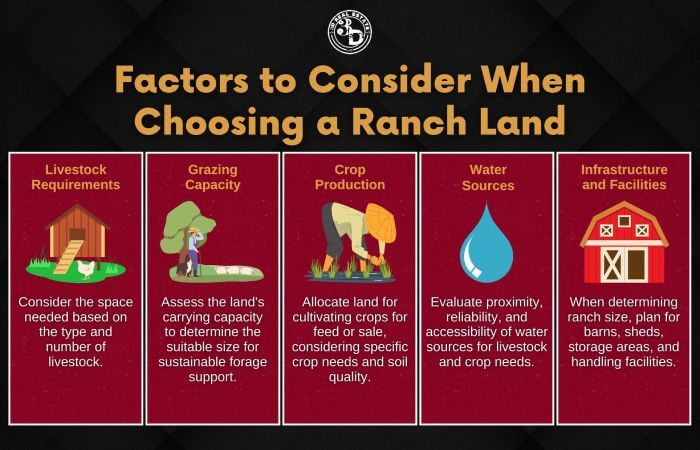
- Livestock requirements: The type and number of livestock you plan to raise will influence the amount of land you need. Different animals have varying space requirements for grazing, shelter, and exercise. For example, cattle generally require more land per animal than smaller livestock like goats or sheep.
- Grazing capacity: The land’s carrying capacity refers to the number of animals the available forage can support sustainably. It depends on soil fertility, vegetation type, and climate. Understanding the land’s carrying capacity helps determine the appropriate size of your ranch.
- Crop production: If you plan to grow crops for feed or sale, you must allocate additional land for cultivation. Take into account the specific crops you intend to cultivate and their spatial needs. Also, assess the soil quality on the ground you’re considering for its suitability for crop production.
- Water sources: Water availability is crucial for livestock and crops. Consider the proximity of water sources such as rivers, creeks, or wells, and assess their reliability and accessibility for your ranching activities. Additionally, evaluate the quality and quantity of water available for your needs.
- Infrastructure and facilities: Besides grazing and cultivation areas, you’ll need space for infrastructure and facilities like barns, sheds, milking parlors, storage areas, and handling facilities—plan for these structures when determining the size of your ranch.
It is suggested to ask for advice and guidance from local agricultural experts, extension offices, or experienced ranchers in your area, who can offer valuable insights and assistance tailored to the specific conditions and requirements of your region. In addition, they can assist you in evaluating the land and making informed decisions about the size of the ranch you’ll need for a successful operation.
Government Regulations
To guarantee the welfare of animals and the environment, it is crucial to have knowledge of the specific regulations and guidelines pertaining to livestock farming. Here are some important considerations:
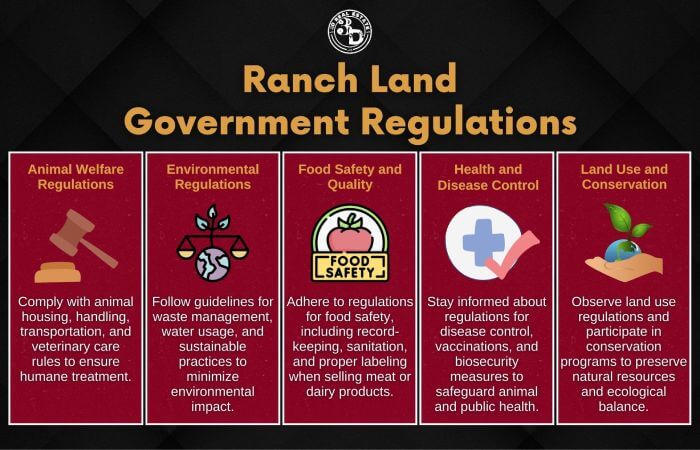
- Animal Welfare Regulations
Different jurisdictions have regulations in place to ensure the humane treatment of animals. These regulations may cover housing conditions, handling practices, transportation, and veterinary care. Familiarize yourself with these regulations to ensure you meet the standards for animal welfare.
- Environmental Regulations
Livestock operations can have environmental impacts, such as waste management and water usage. Therefore, it’s crucial to comply with regulations related to manure management, water pollution prevention, and land conservation. In addition, understanding and implementing sustainable practices can help minimize adverse environmental effects.
- Food Safety and Quality
Suppose you plan to sell meat or dairy products from your ranch. In that case, you’ll need to comply with food safety regulations to guarantee the quality and safety of your products. It may involve maintaining proper records, implementing sanitation practices, and adhering to labeling requirements.
- Health and Disease Control
Livestock diseases can have severe consequences for the industry and public health. Stay updated on regulations related to disease control, vaccinations, and biosecurity measures. Compliance with these regulations helps prevent the spread of diseases. In addition, it safeguards the health of your animals and the broader livestock community.
- Land Use and Conservation
Based on the size and scale of your ranch, you may be required to comply with land use regulations and participate in conservation programs. These regulations aim to protect natural resources, prevent soil erosion, and maintain the area’s ecological balance.
Remember, regulations can vary between jurisdictions, so it’s essential to research and consult with local agricultural authorities, extension services, or legal professionals who specialize in agriculture to ensure you have accurate and up-to-date information for your specific region.
Size of Land Needed for Different Animals
Determining the appropriate size of land for a ranch relies on factors such as the type and quantity of animals being raised. It is crucial to comprehend the space requirements for each animal, ensuring sufficient grazing land and promoting their overall well-being.
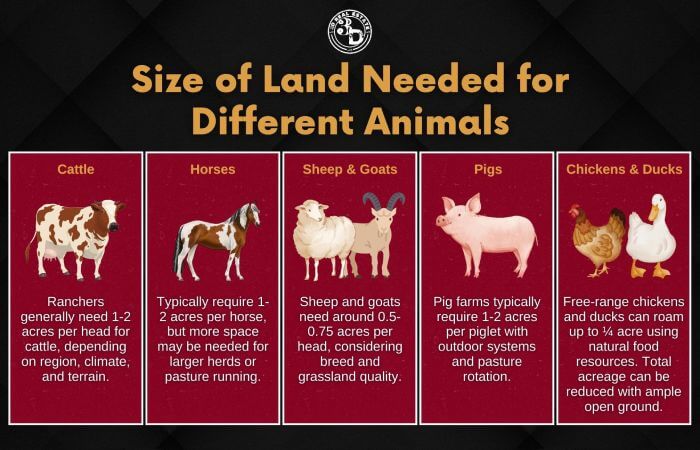
- Cattle – For cattle, ranchers typically need about one to two acres per head, depending on the region, climate, terrain, etc.
- Horses – Similar to cattle, horses generally require between one and two acres per horse. However, more space may be needed for larger herds or if they run at pasture most days of the week.
- Sheep & Goats – As small grazers, sheep and goats usually only need around 0.5-0.75 acres per head. However, it can rely on the breed and other factors like grassland quality and availability.
- Pigs – Pig farms vary significantly in size according to their purpose (i.e., meat production vs. breeding) but typically require 1-2 acres per piglet when fed outdoors with access to pasture rotation systems.
- Chickens & Ducks – Free-range chickens and ducks will roam up to ¼ acre while still providing enough food resources like bugs, weeds, and grasses, which means that you can get away with fewer total acres if your flock has plenty of open ground within its boundaries.
Considering all these factors together helps determine how much land you need for a ranch in any given livestock operation; however, there is also the cost of land acquisition and maintenance associated with owning a farm which should be considered before making any final decisions. Nevertheless, knowing this information allows potential ranchers to make informed decisions about their operations from an economic and proper resource management perspective.
Cost of Land and Maintenance

When it comes to ranching, the cost of land and maintenance is paramount. Purchasing land can be a costly investment, with many factors that need to be taken into account. The following table will help you understand some of these costs better:
| Land Ownership | Cost of Land | Ranch Upkeep |
| Lease | Low | High |
| Buy | High | Low-High |
| Joint Venture | Moderate | Moderate-High |
If you decide to lease land for your ranch, you’ll pay less upfront but more in ongoing fees and taxes over time. Buying land initially is expensive but may come with fewer long-term expenses like leasing does. When considering the best place to buy land for your ranch, you must consider various factors such as soil quality, climate suitability, access to water sources, proximity to markets, and the availability of necessary infrastructure. With a joint venture option, there’s an even balance between upfront costs and ongoing upkeep fees.
Regardless of your decision about purchasing land for your ranch, remember that proper land stewardship is crucial to its success. It includes regular maintenance of fences, water sources, pastures, and facilities and tracking livestock movement.
By understanding the financial implications of owning or leasing land for your ranch and knowing what goes into maintaining it properly, you’ll be able to find the right location for your operation before making any big decisions.
Finding the Right Location to Build a Ranch
When looking for land to start a ranch, it’s essential to consider various elements. Location is critical when selecting the right property for your operation. Here are the following factors to think about:
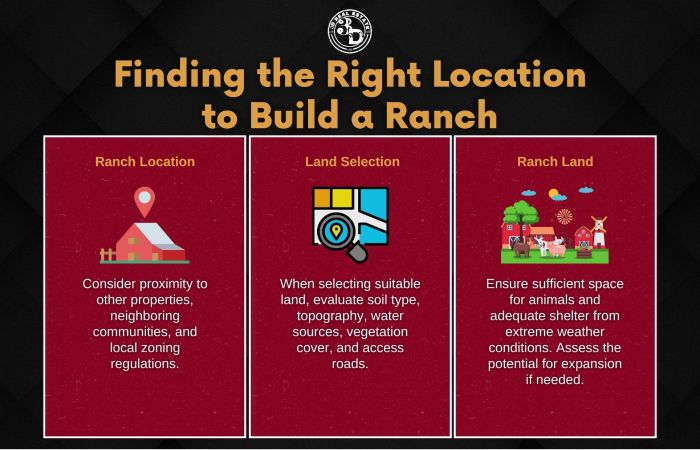
- Ranch location
Consider the proximity of the ranch land to other properties and neighboring communities. It will affect how much control you have over activities such as hunting, grazing, and logging on your property. It’s also wise to look into local zoning regulations and any restrictions that may impact your operations.
- Land selection
Pay close attention to unique land features like soil type, topography, water sources, vegetation cover, access roads, and trails. These can play an essential role in determining which livestock species are suitable for your land and whether or not specific management strategies should be implemented.
- Ranch land
You’ll want to ensure enough space for all the animals you plan on keeping and that the terrain provides sufficient shelter from extreme weather conditions. Additionally, assess if there’s room for expansion if you decide to add more acreage.
To create a successful ranching business, careful consideration must be given when selecting the appropriate land for this endeavor, including how much land you need for a ranch. By researching local zoning laws and taking note of specific land characteristics such as soil type, topography, vegetation cover, and the required acreage, one can better ensure success with running a successful ranching operation.
The Bottom Line
Engaging in ranching can bring about both satisfaction and profitability. However, it is crucial to grasp the required land size for successful ranch operations. Each situation is unique and demands meticulous deliberation of government regulations, the specific livestock being raised, the expenses associated with land acquisition and upkeep, and the preferred location. By considering these factors comprehensively, you will better understand the amount of land necessary for your ranch.
At 3D Real Estate, we understand the intricacies of determining the ideal land size for successful ranch operations. With our extensive knowledge and tailored guidance, we can help you make well-informed decisions regarding the land size required for your ranch. So contact us today and begin your rewarding and profitable ranching journey with confidence.




